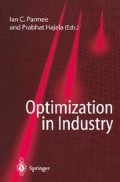Abstract
In the recent years many successful applications of evolutionary algorithms to aerodynamic design problems have been reported. The two main problems in applying evolutionary algorithms to that field are the high computational cost of the quality evaluations and the parameterisation of the design. In order to solve these problems, it is necessary to find the best simulation methods and strategies for the optimisation in order to reduce the overall computation time. In this paper different Evolution Strategies are compared with respect to their applicability to the optimisation of gas turbine blade designs. Additionally a representation with a low number of parameters is necessary in order to reduce the time needed for the optimisation. On the other hand the representation should be as variable as possible to allow the description of a wide range of possible designs. In order to optimally solve this trade-off between compact representations and detailed descriptions an adaptive representation is proposed. This representation is compared with fixed representations with respect to the optimisation time and the quality of the final result.
Access this chapter
Tax calculation will be finalised at checkout
Purchases are for personal use only
Preview
Unable to display preview. Download preview PDF.
References
S. Obayashi, Y. Yamaguchi, and T. Nakamura, (1997) Multiobjective genetic algorithm for multidisciplinary design of transonic wing planform. Journal of Aircraft, 34 (5): 690–693.
J Sobieszanski-Sobieski and R. T. Haftka, (1996) Multidisciplinary aerospace design optimization: Survey of recent developement. In 34th AIAA Aerospace Sciences Meeting and Exhibit, Reno, Nevada. AIAA Paper 96–0711.
A. Vicini and D. Quagliarella, (1998) Airfoil and wing design through hybrid optimization strategies. In 16th Applied Aerodynamics Conference. American Institute of Aeronautics and Astronautics, 1998. AIAA Paper 98–2729.
D.J. Doorly,(1995) Parallel genetic algorithms for optimization in CFD. In J. Periaux and G. Winter, editors, Genetic Algorithms in Engineering and Computer Science. Wiley.
B. R. Jones, W. A. Crossley, and A. S. Lyrintzis, (1998) Aerodynamic and aeroacoustic optimization of airfoils via a parallel genetic algorithm. In Proceedings of the 7th AIAA/USAF/NASA/ISSMO Symposium on Multidisciplinary Analysis and Optimization, AIAA-98–4811.
M. Olhofer, T. Arima, T. Sonoda, and B. Sendhoff, (2000) Optimisation of a stator blade used in a transonic compressor cascade with evolution strategies. In I. Parmee, editor, Adaptive Computation in Design and Manufacture (ACDM), pages 45–54. Springer Verlag.
C.M. Fonseca and P.J. Fleming, (1998) Multiobjective optimization and mul¬tiple constraint handling with evolutionary algorithms - part II: Application example. IEEE Transactions on Systems, Man and Cybernetics, 28 (l): 38–47.
A. Ostermeier, (1994) A derandomized approach to self adaptation of evolution strategies. Evolutionary Computation, 2 (4): 369 - 380.
N. Hansen and A. Ostermeier, (2001) Completely derandomized self-adaptation in evolution strategies. Evolutionary Computation.
Y. Jin, M. Olhofer, and B. Sendhoff, (2001) Managing approximate mod¬els in evolutionary aerodynamic design optimization. In Proceedings of IEEE Congress on Evolutionary Computation, volume 1, pages 592–599, Seoul, Ko¬rea.
M. Olhofer, Y. Jin, and B. Sendhoff, (2001) Adaptive encoding for aerodynamic shape optimization using evolution strategies. In Proceedings of IEEE Congress on Evolutionary Computation, volume 1, pages 576–583, Seoul, Korea.
T. Bäck, D. Fogel, and Z. Michalewicz, editors, (2000) Evolutionary Computation 1, Basic Algorithms and Operators. Institute of Physics Publishing Ltd..
N. Hansen and A. Ostermeier, (1996) Adapting arbitrary normal mutation distributions in evolution strategies: The covariance matrix adaption. In Proc. 1996 IEEE Int. Conf. on Evolutionary Computation, pages 312–317. IEEE Press.
M. Fischer, (2001) Evolutionäre Optimierung von Spline-codierten Strukturen. Master’s thesis, University Bochum, Institut für Neuroinformatik, Bochum, Germany.
Author information
Authors and Affiliations
Editor information
Editors and Affiliations
Rights and permissions
Copyright information
© 2002 Springer-Verlag London Limited
About this paper
Cite this paper
Olhofer, M., Arima, T., Sonoda, T., Fischer, M., Sendhoff, B. (2002). Aerodynamic Shape Optimisation using Evolution Strategies. In: Parmee, I.C., Hajela, P. (eds) Optimization in Industry. Springer, London. https://doi.org/10.1007/978-1-4471-0675-3_8
Download citation
DOI: https://doi.org/10.1007/978-1-4471-0675-3_8
Publisher Name: Springer, London
Print ISBN: 978-1-85233-534-2
Online ISBN: 978-1-4471-0675-3
eBook Packages: Springer Book Archive

